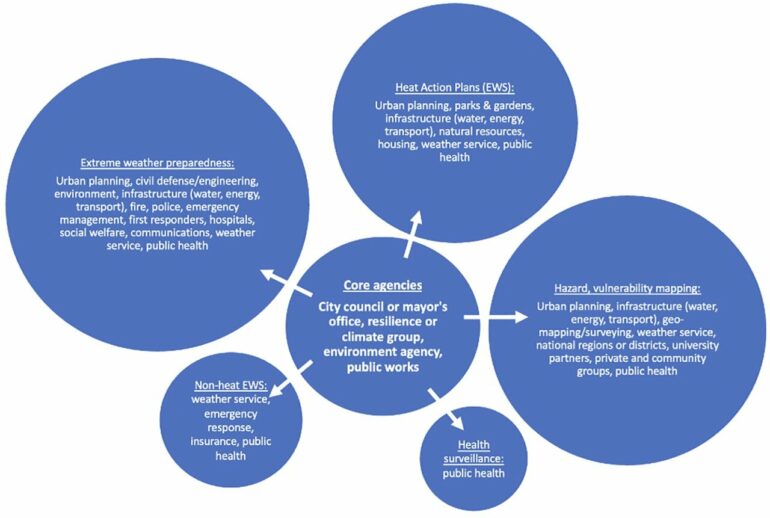A review of 22 large cities’ climate adaptation plans finds that while most include meaningful actions to promote public health, fewer cities have involved their public health agencies in these plans. Mary Sheehan of the Johns Hopkins Bloomberg School of Public Health in Baltimore, Maryland, and colleagues present these findings in the open-access journal PLOS Climate on March 3.
With climate change, urban populations are at increased risk from a number of hazards, including heat, flooding, and drought. Many cities have chosen to develop climate adaptation plans, which include a major focus on public health. However, due to limited research, the extent to which even highly health-focused cities’ plans incorporate public-health actions and involvement from public health agencies has been unclear.
To improve understanding, Sheehan and colleagues evaluated the climate adaptation plans of 22 large cities that were already known to be focused on adaptations promoting public health. They analyzed the extent to which these cities’ plans include actions falling into five categories thought to be promising for promoting public health, such as preparedness for extreme storms or early-warning systems for infectious disease.
The analysis found that 90 percent of the plans include actions in at least three of the five health-associated categories. Among those plans, however, only 73 percent include involvement from a public health agency. Cities in low- and middle-income countries were more likely to involve public health agencies in climate change adaptation plans than cities in high-income countries, though cities with meaningful involvement of public health agencies also included Barcelona, Baltimore, and San Francisco. Plans with greater involvement from public health agencies more frequently involved heat early warning, followed by actions in extreme weather preparedness and hazard mapping.
The analysis also examined varying approaches to climate adaptation plans. For instance, Baltimore’s plan is coordinated by its Office of Sustainability and includes a major focus on extreme-weather preparedness, while London’s is coordinated by the Mayor’s office and includes a broader focus on environmental strategies. Barcelona’s plan demonstrates integration of multiple city agencies in addressing adaptations to protect public health.
The researchers say their findings support efforts to more deeply involve public health agencies in climate change adaptation and outline additional opportunities for large cities to incorporate public health in adaptation plans.
The authors add: “Localities are driving climate adaptation, and in this study we found that local public health involvement in climate adaptation plans can make a difference. Where city health agencies were engaged in climate plans we saw preventive actions like extreme heat warnings more commonly reported. Public health presence brings data, for example on health impacts and vulnerability, that can result in greater focus on people—and better protection for those who need it most. Looking forward, we found there is opportunity for more public health involvement in areas like extreme weather preparedness and vulnerability mapping, in partnership with emergency management, weather services and other agencies.”
More information:
Sheehan MC, Khudairi F, Swaich GS, Hines W, Mehta S, Fox MA (2022) Urban climate-health governance: Charting the role of public health in large global city adaptation plans. PLOS Clim 1(3): e0000012. doi.org/10.1371/journal.pclm.0000012
Provided by
Public Library of Science
Citation:
How 22 large cities address public health in climate adaptation plans (2022, March 3)



